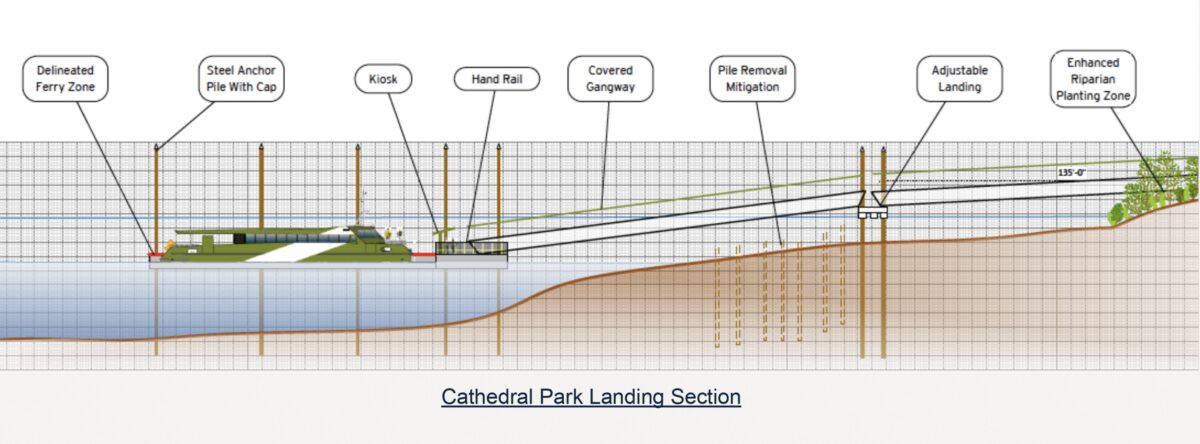
“That first and final mile is just huge. And I can really see Biketown being a key part of this, especially with e-bikes.”
— Susan Bladholm, Frog Ferry
A public passenger ferry system that would serve 9 stops between Vancouver and Oregon City on the Willamette River would cost about $40 million to launch and would need about $7 million a year to operate. Those are just two takeaways from the Operational Feasibility Study and Finance Plan released by Frog Ferry this morning (PDF).
Frog Ferry, a nonprofit that first floated the idea of a carfree ferry system in 2017, has made major progress toward their goals since we first covered them two years ago.
At the online press conference Tuesday morning, Frog Ferry Founder and President Susan Bladholm said ferries offer, “An amazing opportunity to expand our transportation network at a fraction of the cost of other modes.” Bladholm then shared a new promotional video where a narrator said, “Imagine getting to work faster, while feeling your heart beat slower.” “Welcome to Frog Ferry, a walk-on, walk-off boat that will whisk people up and down the Portland area with a vision to go even further… The time for Frog Ferry is now. The river is our transportation future.”
Bladholm and her supporters have reason to be excited. Since 2017 they’ve put together an impressive list of backers and board members, secured a $200,000 planning grant from the Oregon Department of Transportation (which included $40,000 from the Portland Bureau of Transportation), claim to have raised $750,000 from donors and added 1,600 people to the Friends of Frog Ferry support group, have used the equivalent of over $5 million in pro bono management and marketing work and have published three reports (best practices, demand modeling and now operational finances and feasibility).
Here are the main takeaways from their latest report:
Advertisement
- Recommendation of seven vessels (with different sizes south and north of OMSI based on river environments and wake zone regulations).
- Average 3,000 passengers a day and 800,000 per year
- Capital Costs ($40 million): Planning, engineering, vessel and equipment acquisition, and regulatory requirements
- Operating Costs ($6.8 million): Labor, fuel, insurance, maintenance, technology, communications and training
- Annual subsidy: $2.5 million (ticket revenue covers 45% of costs)
- Cost per passenger: $8.50
- Average passenger ticket price: $5 per passenger | $3 for honored passenger
The route would be split into two sections, a lower river route (north of downtown) and upper river route (south of downtown). Five terminals would be included in the “core route”: Vancouver (Terminal 1), Cathedral Park, Salmon Street, OHSU, and Lake Oswego. Time estimates for a trip between Vancouver and Salmon Street Fountain would be about 44 minutes on an express route and 55 minutes with a stop at Cathedral Park. Headways between ferries would be 30 minutes max.
The boats would vary between 90 and 65 feet long and would have room for 100 and 70 passengers respectively. In an interview last week Bladholm told me the smaller vessels would have space to park 12 bikes and the larger ones would be able to fit about 15 bikes.
The estimated number of people who will ride bikes to the docks is unknown at this point. Bladholm hopes to complete a more detailed modeling study next year. One thing we do know is that many riverfront locations are not easy to get to by bike (or foot for that matter). Cathedral Park in St. Johns for instance is expected to be a key Frog Ferry station. Unfortunately the riverfront is down a steep hill and the dock would require people to cross heavy railroad tracks. “That first and final mile is just huge,” Bladholm said when I asked her about this. “And I can really see Biketown [bike share] being a key part of this, especially with e-bikes.”
The report acknowledges the important role of bicycle access, bike parking, bike share, and walking. People on foot should be able to reach ferry terminals “uninhibited” and bicycle access at both ends of a trip, “will be of critical importance” the report states. Since the boats won’t be able to fit everyone’s bikes, “Secure bike parking in close proximity to the terminal is essential,” it adds.
Commuters were expected to be the top user segment of the new ferries. Even with major commute behavior changes brought on by the Covid-19 pandemic, Bladholm believes there’s a need for ferries. Using the Cathedral Park example, she said her contacts at OHSU tallied about 500 employees a day coming from St. Johns to the south Waterfront campus and Marquam Hill. Today that number is around 300. “That count is great for us,” Bladholm said, while explaining how a typical bus commute would be over an hour and a ferry ride would be just 22 minutes.
Addressing the Covid impact in a recent newsletter to supporters, Bladholm said, “Our public agencies are recalibrating planning strategies and looking at low-cost, high-value ways to build our economic vitality while improving our environmental footprint. This is an opportunity to revisit our values in a more meaningful way, rather than continuing with the status quo of transit planning based on what has been done in the past.”
Beyond commuters, Frog Ferry’s three other target markets are: first responders and “citizens in distress” during an emergency, locals running errands or meeting friends, and tourists.
Advertisement

Bladholm said she’s comfortable being in the role of pushing for something new that gets dismissed by some people. Back in 1987 when she was 22 and fresh out of college, Bladholm took a job working with Oregon’s first-ever state tourism director. Her first assignment was to look into a new thing called Cycle Oregon that her boss had read about in the newspaper. Bladholm dove head-first into the job and traveled to Iowa to learn about large group rides first-hand at the legendary RAGBRAI event. When Cycle Oregon launched in 1988 Bladholm was its first ride director and she served in that role for three years.
“Pre Cycle Oregon we had no cycling culture here, let alone no infrastructure,” Bladholm shared with me last week. “So this is so reminiscent of it, it’s just that I’ve got the benefit of being 32 years older.” “We’ve been backed into that corner so many times and told, ‘You’ve got to do this, you got to do that. Oh, here are three more things you’ve got to do’. Well we’ve done them now,” she added, confidently.
Bladholm will need this confidence to take the major steps that remain before any boats get on the water.
Frog Ferry needs to find a public agency sponsor to help them get in line for major federal funding. So far no one has stepped up. An operational model they’re looking to is something similar to Portland Streetcar Inc., whose director Dan Bower sits on the Frog Ferry board (he also used to be head of active transportation at Portland Bureau of Transportation). The other to-do item atop Bladholm’s list is to plan and fund a pilot project that would begin in 2022.
If all goes according to plan Frog Ferry will be in region-wide operation by summer 2024.
(Below is the Frog Ferry promo video released today.)
— Jonathan Maus: (503) 706-8804, @jonathan_maus on Twitter and jonathan@bikeportland.org
— Get our headlines delivered to your inbox.
— Support this independent community media outlet with a one-time contribution or monthly subscription.


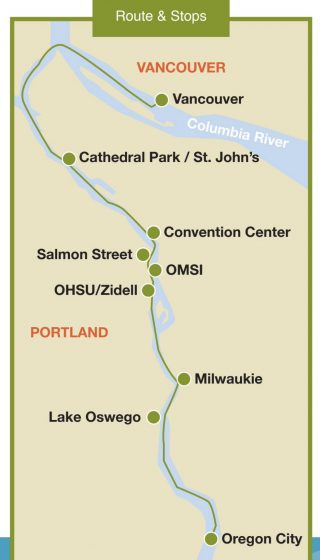
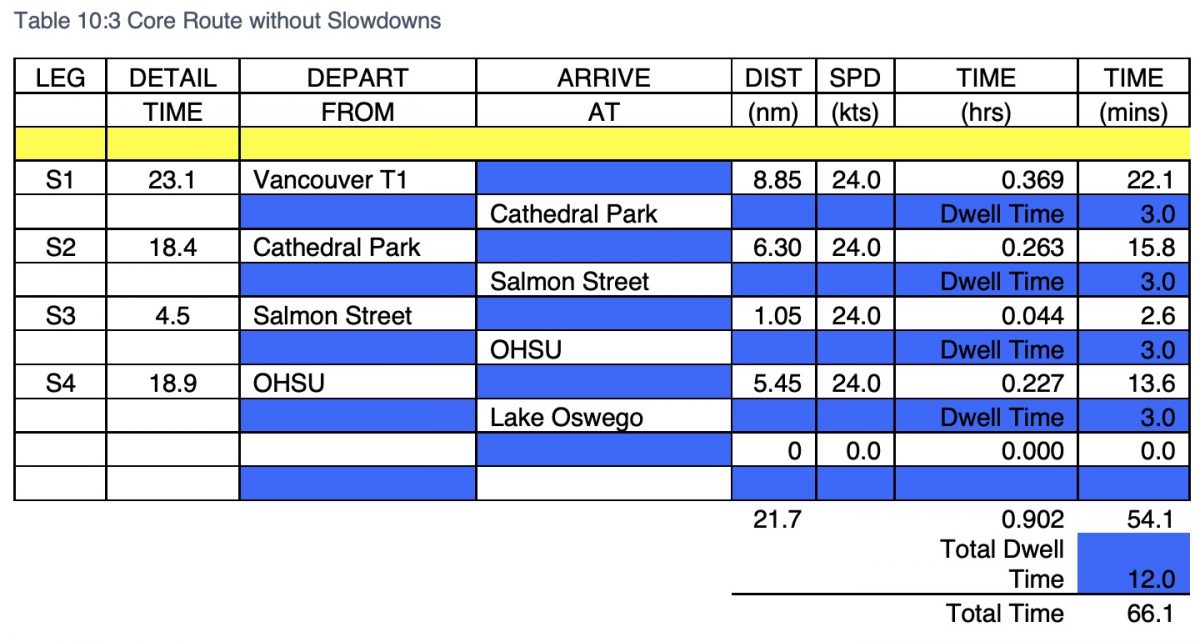


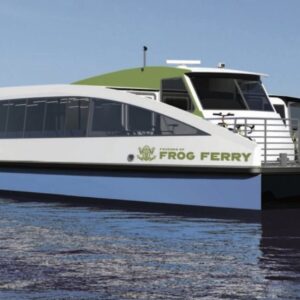

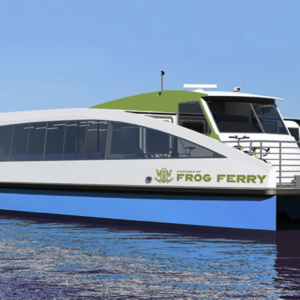
Thanks for reading.
BikePortland has served this community with independent community journalism since 2005. We rely on subscriptions from readers like you to survive. Your financial support is vital in keeping this valuable resource alive and well.
Please subscribe today to strengthen and expand our work.
A vanity project for a well-connected person, who, so far, has gotten governments to give her organization $200,000. We should be spending the money on projects with proven results, not this pipe dream.
Yea, good point, there are definitely no successful ferries operating out there. The travel time is pretty comparable to bus commute times during rush hour – should we shut those down, too? Or should we keep trying to convince WA to put in light rail?
edit: Definitely playing devil’s advocate, but the political will to get any of the other things done sort of seems like a pipe dream as well at this point.
Fingers crossed…
I can’t believe we’ve already wasted $250k on this thing. I guess the flipside of TriMets garbage service out to St. Johns makes the ferry look somewhat reasonable.
Is something wrong with bus route # 16?
Nothing wrong with it you don’t mind spending 2.5+ hours to commute 16 miles round trip each day.
An express bus would match the transit time of the ferry at a fraction of the cost.
Ferries make sense for water crossings where a roadway alternative doesn’t exist. They don’t make sense in Portland because we have over a dozen bridges and many roadways that parallel this proposed route. The proposed ferry trip is actually several miles LONGER than taking I-5 from Vancouver.
This proposal is so silly.
It would seem there are a lot better ways to spend $40,000,000 in startup costs and $7,000,000 per year to operate. Bus Rapid transit with electric buses maybe?
If there is any federal subsidy, and given that it is transit there probably will be, then the system will need to be ADA as well. It’s not impossible, Venice has a fully ADA-compatible canal frequent-bus system, as is the Vancouver SeaBus on the Burrard Inlet.
It would be fun to take a ferry ride – on a nice day with a gentle breeze and warm weather. I’d love to take out-of-town guests for the entire trip from Oregon City to Vancouver. As for regular commuting, you’ve got to be kidding. I don’t think they can keep to the planned schedule or attract nearly the ridership they estimate.
Sorry, but there’s been too much spent on this already. Give us something useful like more signalized crossings for bicyclists and pedestrians, protected bike lanes, or return of fareless square.
Reminds me of Ashlands brilliant plan to spray tourist poop on a hillside and call it sewage treatment. But Portland could defund its limpdick copshop and pull it off. . .
I would prefer to put the money to fareless travel for all of trimet, not just a return to the fareless square . We would probably save money in the long run by not having to spend as much on our roads and expanding the freeways.
The presumption buried in your statement is that people prefer driving to transit because transit is too expensive. There may be other factors at play that reducing fares will not address.
Completely unnecessary and inefficient.
Yeah, you’re right, but like Jason below, I love it. When you get right down to it, freeways, car ownership, and washing machines are also unnecessary and inefficient, but most people in the USA can’t live without them. It’s all about having more options, more ways of getting around.
The whole point of being Republican is giving people more options to live their lives, of not having everyone being forced to conform to a Puritan society of the masses, but allowing everyone to choose their own destiny. This ferry is a throwback to an earlier time in Portland’s history when the community was focused along the waterfront rather than along freeways, when most people walked and bicycling was an alternative mode along with horses, trolleys, and buggies.
Not sure where your “Republican” reference came from. But my view of “giving people more options” and “allowing everyone to choose their own destiny” would mean if you want to ride a boat, fine. Pay for it yourself. Don’t expect others with different “destinies” to subsidize yours.
Do you mean as opposed to my having to pay for roadways for you to drive your car on and to park (store) it on my public street, instead of using that same space for public transit and/or protected bike lanes?
What amazes me is how many otherwise rational individual bicyclists will blindly vote for a certain political party that has a governor and state legislature who are fully committed to ramming the Rose Quarter freeway project into Portland, as well as Metro funding that can and will be diverted to that same project, and state legislation to allow drivers to go as fast as possible with little or no speed enforcement.
The Rose Garden project is a perfect analogy–one that benefits only some people, at enormous cost paid by others.
Of course we all pay for public projects that we may not use ourselves, but of course people also oppose spending when they believe the money could better benefit more people if spent another way.
I’m still not sure why you’re inserting Rebublican vs. Democrat into this. Ironically, I’d guess this project would be stridently opposed by the vast majority of Republicans, for the same reason I mentioned (“pay for it yourself if you want it”). Here on Bikeportland, where I’d guess there aren’t a lot of Republicans, there seems to be a lot of opposition as well.
I understand the general gist of your comment, but I have a good idea about how the Puritans would feel about gay rights, abortion and interracial marriage – they’d not approve of people having those options. Now, an actual Libertarian might go along with those options, but not a Republican or Puritan.
My own opinion is that this as option that there really is not a demand for, and we already have several options available. Maybe we can subsidize personal jetpacks…
You are mixing up Puritans with evangelical Christians and the “moral majority”. They are not at all the same thing. Puritans believe in a strong militarized centralized government and a conformed society based on Christian principals and their current interpretation of what they think the bible says, based on their 1640s dogma, abolishing the Kingdom of England, and subsequent actions by Oliver Cromwell. Since they still largely run Massachusetts and Connecticut, one can assume they are now okay with LGBT rights, legalized abortion on demand, and allowing for interracial marriage. Evangelical Christians on the other hand…
Also keep in mind that most Democratic congresspersons represent themselves to the public as Christians of one sort or another – they regularly attend church and court Black evangelical voters. They may not be as extremely evangelical as some of the Republicans purport themselves to be, but they are hardly agnostic nor atheist. The Democratic Party is not really a Bernie Sanders social democratic party of European type, but more of a Christian Democratic of a German type – conservative, but not right-wing.
This project does align with Republican values because it will subsidize middle-upper class commuters and provide them with a transportation option that allows them to avoid sharing space with the poors. It’s also a project with highly questionable finances that will inevitable increase. At least the private operator gets to guarantee their profits, right?
I agree, as with tollways and Amtrak commuter rail, it’s a middle-class rip-off. I think it much more ultimately likely it will be a public transit system rather than a commercial or nonprofit company, but it will still be the poor paying to subsidize public transit for the middle-classes (i.e. rich), like a waterborne BRT. It’s the kind of public transit that Republicans in most of the USA can get behind, but in Oregon it will be the conservative half of the Democrats who will spearhead support for it, the same as who sponsored concealed handguns, 75 mph speed limits, and the Rose Quarter freeway expansion, the people y’all will re-elect in November.
When the Republican side of the aisle is saying things like “if you send police to get me, make sure to send bachelors”, there aren’t a lot of valid options for the legislature. I would at least consider an honest to goodness small government conservative, but I don’t think they exist anymore. Too bad because we need someone to hold the Dems’ feet to the fire, and the right has refused to be the loyal opposition.
I never understood this comment; were the Republicans looking to for police to marry?
“Make sure they don’t have families, because I will shoot them dead.”
I’m still reading it as “send eligible bachelors, in snappy outfits, for us to marry.” It must be lonely being a Republican in Salem these days.
…a waterborne BRT…
Whoa. BRT is not a middle-class perk, unless you put it in a place with no poor people. Bus service that is fast and doesn’t suck serves everyone who gets on board.
Lots of issues with FF. That’s a shoestring budget and I would have to see a lot more to believe. Is there some reason Portland Spirit isn’t doing this already? They’re in the boat business after all.
I would say it’s more akin to commuter rail, or express bus services, like the ones they run up in Puget Sound. Those cater to a higher income 9-5 commuter, and are often not very useful for those working lower income jobs because they run during peak hours and have limited frequency. This ferry would be no different. It definitely won’t be running at 6am or 10pm.
Any way to handcuff the financing to sidewalk building and expansion of Tri Met’s Eastside routes? This is why Northwestern cities need city council representation by geography.
I love it!
On the one hand, given what highways cost, this looks like a bargain. On the other hand, I agree with most here that this is a boondoggle that won’t move the number of people claimed in the time claimed. Would probably be cheaper to buy some rolling stock and run commuter trains down the Amtrak lines from Vancouver to Union Station.
Cheaper still would be to offer free door-to-door limousine service.
You have to compare the costs at a per-user level. The I-5/I-205 bridges have about 300,000 crossings per day. Even if average vehicle occupancy is only 1.3 passengers, that still absolutely dwarfs the 3,000 daily passenger estimate for this ferry service. If we spend the same amount per passenger for a bridge project, that would give us over $5 billion to work with…
Awesome work. I admire the hustle. Very visionary concept. Major props to Susan!
In general I like ferries. They make plenty of sense for locations separated by bodies of water. Portland was full of ferries before bridges were built. Wouldn’t it make more sense to build a new bridge over Columbia River with dedicated bike and transit facilities? It could carry tens of thousands of people much faster (if designed properly) and allow for transit that takes people into the center of destination areas rather than the fringe. It would allow for improved mobility and accessibility to places where people want to go. Also buses and trains can stop to unload and load passengers in less than 30 seconds, as opposed to 3 minutes.
I would poke at the travel times provided. Do they account for the time it takes for a boat to dock and leave the dock? The ferries in Seattle slow down considerably in order to properly dock and while I’m always amazed at the professionalism of the boat pilots, it’s not a quick operation in even the best of weather.
The northern section doesn’t make sense because the river doesn’t go the right way. E-Bikes (esp the 28mph kind) get the trip done in half the time from Vancouver to Portland and get you door to door.
The southern section mainly serves wealthy suburbs, so I think there are some equity concerns there.
This is obviously true with or without $250k in feasibility study fees.
I don’t buy the figures above. At over $6 per trip in just operating costs, I don’t see this paying for itself. $40 million spread out over 10 years over 3,000 passengers per day is almost $4 in passenger subsidies per day. That’s on top of the 45% they noted as a baseline subsidy.
No. Just, no.
This is a wonderful idea. In transportation, it is good to have an abundance of options. And compared to the cost of maintaining the road system, which is not free, this is a bargain.
3,000 people per day? That doesn’t seem realistic. It must be 1,500 round trips per day. Even that is a head scratcher. Average cost of a ticket is $5. Now it’s $10 for that round trip. C-tran already does this for $7.70/round trip (less with a monthly ticket).
If the numbers dip below that 3000 level, your subsidies will balloon quickly.
The project’s feeble transportation modeling assumes that we build 1,500 parking spaces (500 each in Vancouver, St. Johns and Oregon City), but the project budget includes zero dollars for parking.
ECONW’s base case suggests as few as 80 passengers per day on the “express” routes here. Also: Frog Ferry’s PDF didn’t show the appendices to the ECONW report that give the details of the traffic modeling.
I read that Vancouver is now only a future phase extension vs. a primary phase. Sadly the Vancouver side of things is “asleep at the wheel” in past discussions with major stakeholders and FF. [Seems very similar to how the Fourth Plain B[r]T project got too far along in SOW and the CoV missed greater improvements to the arterial corridor other than spot transit work..vs how PBoT uses TRIMET projects for full corridor reconstruction. Some of this missed work the CoV is now having to fund directly vs FTA/ Feds from what I recently saw in the budget.]
I would like a ferry, but I would first prefer rebuilt rails between Vancouver, Washington and downtown Portland, Oregon. Why not invest in rail?
40 million would go a long way towards replacing the railroad swing bridge, which is older than both of the I-5 bridges and is a big bottleneck for the west coast mainline.
Rail Bridge 9.6 is circa 1908 (I thought it was 1910 until I looked it up today)
Yes, the Vancouver folks protested to THE Sam Hill to make the rail bridge* a “two decker” crossing for their auto wagons but Sam said “No Way in Hill”. This was the first bridge across the mightly Columbia. Nothing changes….
Money for transportation projects is often held in silos – that is, there’s so much for highways, so much for railroads, so much for sidewalks and bikeways (usually way too little), and so much for waterborn transportation. The states that typically clean up on the ferry funding are Alaska, Washington, Maine, North Carolina, California, NY, Maryland, and a handful of other states. So the theoretical $40 million can’t necessarily be spent on highways, rail, or even beautiful bike bridges. Either Oregon grabs its share of ferry funding, or it looses out to some other state.
Not to say that any transportation project should not have daylight applied to it for cost + opportunity.
The pivot to evaluating a foot ferry service is ‘plain smart’ given it builds on the regional investments in improving river water quality and adding economic vitality to our river communities (vs commercial buildings turning their back to the water) and that fact that regional mobility expansion options have been blocked on land: CRC/ I-5, old Westside Highway, and BNSFs unwillingness to update the main rail bridge (RB 9.6) across the Columbia.
There are not too many more alternative regional route options other than say a hovercar service between Pierson and X [Lloyd Center Mall roof]. Furthermore, as we all know we need some sort of lifeline service options in case the big earthquake hits…its always cheaper to do it before a crisis…kinda like having set up the NSC Pandemic Unit before it was needed (but not closing it). We all would have been better off with more options now.
As a Vancouver (Wa) resident who is not a driver, this is in my opinion brilliant. Not sure if anyone else has tried crossing the interstate bridge by bike lately, but it is frightening. And I would love to be able to take my kid on day trips to Portland. For the record, I d be just as excited for BRT to Portland. But why not both? Why are we continually subsidizing single occupancy drivers rather than mass transit or biking?
I am a big fan of “real” BRT…but sadly I fear if the CRC2 gets built AND BRT is swapped for LRT then the long buses will not be truly RAPID as they will be left to crawl across the new bridge and interchanges in traffic. Over the last 10 years: CTRAN and the CoV does not truly support* BRT since they will not make the dedicated effort to implement dedicated transit lanes (referent to 4th Plain and Mill Plain BRTs). It is not politically easy but it is valuable for consistent lower headways.
*In my long experience here I have found: Too many decision makers for transit in Clark County do not use or depend on transit for their own mobility so important collective sacrifices are not made for the successes of such a service if such have any but token opposition.)
PS. Portland do not let Clark County swap out BRT for LRT as part of CRC2 unless it is truly “rapid”.
Dedicated bus lanes would help sell me a new bridge, but they would need a continuous lane between city centers, at least. Running the buses in the inner HOV lane where they have to fight their way in and out from the exits–not so good.
And per the “lack of car parking” issue…this is a critical issue only if we keep thinking in the old way…and plus we should embrace the challenges to reach these regionally isolated ferry dock areas by car and instead turn it in to an advantage by not promote regional car par + rides as park of this service.
I have suggested before that this project instead focus on enhanced micro mobility access [plus with limited on board moped/ scooter access – like what one sees on the Amsterdam ferries – this would also allow better programatic access to the gas tax revenues vs. just focusing on bikes and shoe modes].
Make lemons into lemonade vs. funding / building another out of date suburban transit park + ride on our riversides.
Only half-serious, but there was a commercial hovercraft service across the English Channel for decades. I just looked it up, and their hovercraft ran at 60 knots. For $40M, can we get a couple of those?
I rode the hovercraft from Calais to Dover in 1999, lots of fun! We were strapped in to a pressurized cabin, then rode just above the waves, periodically crashing into the bigger ones. The service was discontinued in 2001, but there’s still seasonal service between Portsmouth and the Isle of Wight.
It would be fun, but what problem does it solve? It would provide some convenience to some people but at a big cost. It doesn’t save any energy– it is going to be locked into burning fossil fuel for many years. Only one of its stops- Salmon Street- is within walking distance of any density.
It would provide a public transit service even after a major earthquake hit.
assuming bridge wreckage doesn’t block the river, right? I am assuming this could be a problem
Maybe. Or the wreckage of the St. John’s and Fremont bridges will completely block the river.
The lesson from the pandemic is, we’re going to need bandwidth more than buses or boats. Downtown real estate could get really cheap. I just read that Portland hotel occupancy is down 81%. Lots of offices are staffed by about 3 people. As leases expire there will be some hard bargaining.
In past discussions, I’ve seen this compared to the Washington State Ferry System, which is huge and popular. The difference is that those ferries are either the only option (to islands) or the fastest option (going directly across the Sound vs. driving all the way around). Those also give you the option of bringing your vehicle with you.
And even WSDOT ferries are subsidized, to the tune of over $200 million every year.
I’m shocked there is so much naysaying on this idea! I personally love it. It’s another great mode of transportation and could be fun to intertwine with bike rides! It would be super cool for it to stop on Sauvie island, so we can stop biking on the side of hwy 30. A stop on Swan Island would be excellent, there are a ton of people who work there but live far away. I love that it doesn’t allow you to bring a car on board too – makes it cheaper, more efficient, faster, less polluting, less obnoxious, etc etc etc.
“makes it cheaper, more efficient, faster, less polluting, less obnoxious, etc etc etc.”
But even a passenger ferry is worse than alternatives (busses and trains). They cost more per passenger, they pollute more per passenger, and this one is slower.
We need to save the money and use it to extend MAX into Vancouver. Electric mass transit is the only thing we should be subsidizing moving forward.
I’m with you on most of that. Currently ferries are abysmal co2/pass-mile. But, ferries could go fuel cell, or could be natural gas in the short term, battery electric long term. I’m not against commuter rail into Vancouver, I’m ready for the 8B$ project to truly build out an electric train system in Portland and fix all the transportation woes. The Ferry could be alongside this system.
We all would love 1900s commuter electric rail service to Portland…but the bi-state politics are blocking it.
Thus a first phase Oregon only service may be politically easier to start.
The model for financing ferry service is down in the Bay Area. The Golden Gate Ferry is subsidized by tolls on the Golden Gate Bridge. This came about after it was decided to not add a second deck some decades ago. Several bus lines connect to the Ferry in Larkspur and someday, so will, eventually, the new commuter rail line up to Sonoma county. Time to toll the Columbia River bridges!
Make it simpler and require electronic EZ Passes for the Fremont and Marquam bridges, or better yet, all the downtown bridges.
Someone already mentioned a stop at Sauvie, though I’m also wondering why no stop at Swan Island? Is it not an employment center (Daimler, UPS, FedEx, etc.)? I rode the Vancouver BC Seabus frequently, but it holds a lot more passengers and is tied into the public transit system (same as bus fare). Added options are good, but this seems costly for the numbers being served.
It also needs stops at the University of Portland (maybe at the Coast Guard docks?), the dockside apartments between the Fremont and Broadway bridges, Hayden Island, Portland airport, somewhere in the Macadam district, and Sellwood.
Presumably over time, it will spur further development of existing industrial brownfields blocked by railroad lines, allowing a greater employment and housing density along the river.
Every additional stop makes a ferry slower, and people less likely to ride it. What you are proposing just sounds like a light rail line.
Frequent ferry service, Venice: https://www.google.com/maps/@45.4408754,12.3222975,3a,75y,90t/data=!3m7!1e1!3m5!1ssqqF_8PujZJidNCkbgAlKg!2e0!6s%2F%2Fgeo1.ggpht.com%2Fcbk%3Fpanoid%3DsqqF_8PujZJidNCkbgAlKg%26output%3Dthumbnail%26cb_client%3Dmaps_sv.tactile.gps%26thumb%3D2%26w%3D203%26h%3D100%26yaw%3D233.2857%26pitch%3D0%26thumbfov%3D100!7i13312!8i6656
A rough comparison:
Route Seattle–Bainbridge Island
System length 8.6 miles (13.8 km)
Travel time 30 – 35 minutes (2018)
Yearly ridership 6,320,820 passengers (2015)
Cost $16.4 for a standard vehicle; $9.05 for a person going from seattle to bainbridge island
Capacity 2,500 passengers and a maximum of 202 vehicles
Route Vancouver T1-Cathedral Park
System length 8.85 NM (10.1844 miles) (16.39 km)
Estimated Travel time 22 minutes, 8 seconds and an additional 3 minutes of dwell time for ~25 minutes
Yearly ridership ?
Cost $5 for passenger, $3 for honored citizen
Capacity 70 to 100 passengers
Key difference here is that Bainbridge Island to Seattle without the Ferry is 92 miles of driving taking almost two hours.
How long does it take to drive from Vancouver to Cathedral Park?
The ferries work well in Seattle because there really aren’t many easy alternatives to get across the sound.
.
Your comparison shows exactly why this is a bad idea. 3,000 passengers (which is a generous projection) is nothing. It’s a rounding error. Why would we spend $40 million dollars up front and millions per year to subsidize a rounding error?
Sheeh. I live in the Vancouver area and literally no one is going to use this for commuting. If you want to make some new investment in commuting infrastructure between Vancouver and Portland it would make a lot more sense to run frequent commuter trains between Vancouver Amtrak station and Portland’s Union Station. And even that wouldn’t be all that useful
The chart shows a speed of 24 kts, or 28 mph. That sounds incredibly fast for the southern half of the route (downtown to LO) and especially from OHSU to LO. There’s no way that speed would be safe around the Willamette Park boat launch, or Sellwood dock and Sellwood Bridge, or along Ross Island, with so many kayakers, standup paddlers, sailboats (the Willamette Sailing Club is in that area) etc.
There are also several no-wake zones in that area—boat launches, docks, three houseboat communities. I don’t know if any boats exist that can go that fast without exceeding legal wake generation. Wakes are also incredibly damaging to natural areas–such as the entire western shoreline of Ross Island.
There’ve been recent efforts to increase no-wake zones and reduce boat speeds in this stretch. This goes the opposite direction.
Assuming the 24 kts is an average, that also means they’re assuming max speeds much higher, since each port means slowing down to zero then getting back up to speed.
The speeds just don’t sound believable, and even if true, don’t sound desirable for safety or natural resource protection.
How it’s being billed as a commute option seems far fetched. But I love the idea of being able to travel by river. Seems like if FF could find fed dollars and pay for part of its operations itself. It could be a nice addition to Portland. If anything I would take some friends on it when they come to town for something reasonably cheap and yet memorable.
Would probably be smart to start smaller, eliminating the two far out stops and prove it a viable concept first. Then add an express line with those later on.
Okay, this idea is sorta appealing. But, has anyone considered a waterslide crossing the Columbia River?
I love a good ferry. There were naysayers for the Aerial Tram too, but now we can’t imagine being without it. Bring it on! Of course we should also have BRT, and extend rail to Vancouver, etc. but those are completely different government channels with different sources of funding, and we should allow multiple modes to flourish. Working on one project does not necessarily take away from another.
Awesome. I don’t get why there are haters at all…you see little river ferries in Europe all the time